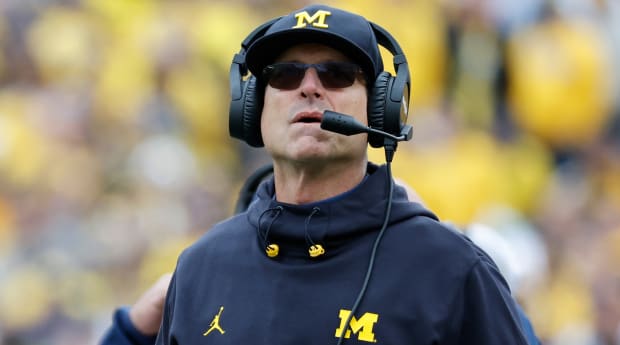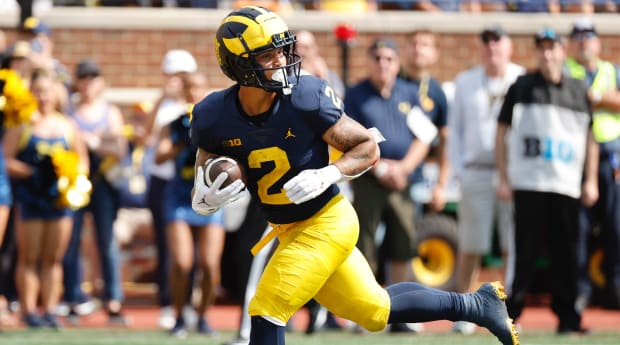Forty names, games, teams and minutiae making news in college football (completed Circle of Suck sold separately in the Pac-12):
MORE DASH: Playoff Picture | A&M’s Implosion | Comeback Stories
Third Quarter
Nonconference Scheduling—How Weak Is Too Weak to Make the Playoff?
At Big Ten media day in July, Michigan coach Jim Harbaugh (21) was asked about a nonconference schedule bereft of Power 5 opponents. The Group of 5 opposition was about as weak as the FBS hierarchy could be: Colorado State, Hawai’i and Connecticut.
The reporter asking Harbaugh the question followed up by observing that “feedback” from fans indicated they want a better caliber of opponent coming to the Big House for nonleague games. Harbaugh’s response: “Well, you can share that feedback at some point with [athletic director] Warde Manuel (22), and you guys can discuss it.”
No telling whether that conversation ever happened, but here is the feedback Michigan has gotten on its schedule from the College Football Playoff selection committee members: they’re not impressed. Committee chair Boo Corrigan (23) has mentioned it as “a factor” in discussing the Wolverines’ place in the rankings—first No. 5, then No. 3—each of the first two weeks.
If Michigan keeps winning, it’s a nonissue. Go 13–0 and beat Ohio State, and the Playoff spot takes care of itself. But if the Wolverines don’t beat the Buckeyes Nov. 26 in Columbus, an 11–1 résumé that has no nonconference meat on the bone becomes a bone of contention.

Rick Osentoski/USA TODAY Sports
This all dials back to decisions Michigan made in 2018 and ’19 to lighten up its nonleague schedule and maximize home games. A two-game contract signed in 2014 to play Virginia Tech (24) for ’20–21 was bought out by Michigan for $375,000 in ’18. A year later, the Wolverines paid $1.5 million to get out of a two-game deal with UCLA (25) for ’22–23. (Hawai’i, the replacement for the Bruins, is getting a Michigan-record guarantee of $1.9 million to play the game in Ann Arbor.)
Those buyouts gave Michigan what it wanted: a minimum of seven home games per season. Changing up the nonconference schedule was driven by the Big Ten’s move in 2016 from eight league games to nine, which necessitated playing five Big Ten opponents on the road every other season. Something had to go from the reduced noncon slate, and Michigan decided it would be road games.
Michigan’s last nonleague road game was in 2018, at Notre Dame. Since then the nonconference schedule has been Middle Tennessee, Army and Notre Dame in ’19; none in ’20; Western Michigan, Washington and Northern Illinois in ’21; and Colorado State, Hawai’i and UConn this year. Next year it is East Carolina, UNLV and Bowling Green. All in the Big House. (Things change in ’24 with a game at Texas, and in ’25 with a game at Oklahoma.)
In terms of maximizing revenue and minimizing defeats, this all makes sense. But the strength of schedule component in CFP deliberation does not favor the current Michigan team in terms of games it has control over scheduling. This could have been alleviated by playing UCLA as scheduled this season. (Michigan officials declined comment to SI on dropping the series with the Bruins.)
The Wolverines have the worst strength of schedule of anyone in the Sagarin Ratings top 25, with a slate that checks in at 71st. Tellingly, the second-worst is UCLA at No. 62, since the Bruins also played a non–Power 5 slate after losing the Michigan game. The Wolverines’ schedule strength certainly will improve in the next two weeks with games against Illinois and Ohio State, but there would be some Playoff peril for a one-loss team which opted to play Nos. 124 (UConn), 138 (Colorado State) and 165 (Hawaii).
This becomes contentious because it’s college football, and everything is contentious, but also because teams from the SEC (26) and ACC (27) only have eight league games and many end up scheduling just one Power 5 nonconference opponent—thus ending up with the same number of P5 games as their brethren in the Big Ten (28), Big 12 (29) and Pac-12 (30).
The average number of P5 opponents played by conference during the 2022 regular season: SEC 9.07; Big Ten 9.79; ACC 9.5; Big 12 10.0; Pac-12 10.0. (West Virginia, Colorado and Stanford are the only three schools in the country to play 11 Power 5 opponents in the regular season. All likely wish they’d scheduled at least one game less ambitiously.)

Rick Osentoski/USA TODAY Sports
If it comes down to a CFP résumé contest for one or more spots between, say, 11–1 Michigan, 11–1 Tennessee, 12–1 Clemson, 12–1 TCU and 12–1 USC—or some combination thereof—here are some numbers to keep in mind.
Michigan would have an 8–1 record against nine P5 opponents: Ohio State (No. 2 Sagarin), Penn State (No. 7), Iowa (No. 24), Illinois (No. 37), Michigan State (No. 46), Maryland (No. 52), Nebraska (No. 76), Indiana (No. 94) and Rutgers (No. 95). Average Sagarin rank: 48.1.
Tennessee would have an 8–1 record against nine P5 opponents: Georgia (No. 1), Alabama (No. 3), LSU (No. 10), Florida (No. 21), Pittsburgh (No. 42), Kentucky (No. 43), South Carolina (No. 57), Missouri (No. 63) and Vanderbilt (No. 98). Average Sagarin rank: 37.6.
Clemson would have a 10–1 record against 11 Power 5 opponents: Notre Dame (No. 15), Florida State (No. 16), Louisville (No. 29), North Carolina (No. 36), Wake Forest (No. 38), NC State (No. 45), South Carolina (No. 57), Syracuse (No. 58), Miami (No. 74), Boston College (No. 106) and Georgia Tech (No. 110). Average Sagarin rank: 53.1.
TCU would have a 10–1 record against 11 Power 5 opponents: Kansas State (No. 11), Texas (No. 12), Baylor (No. 18), Oklahoma (No. 22), Oklahoma State (No. 23), Iowa State (No. 28), Texas Tech (No. 34), Kansas (No. 44), West Virginia (No. 50), Colorado (No. 129) and a Big 12 title-game opponent to be determined. At the moment it would be a rematch with Kansas State, which would give TCU’s P5 opponents an average Sagarin rank of 34.7.
USC would have a 10–1 record against 11 Power 5 opponents: Utah (No. 6), Notre Dame (No. 15), Oregon State (No. 19), UCLA (No. 25), Washington State (No. 32), Arizona (No. 56), Arizona State (No. 59), California (No. 65), Stanford (No. 84), Colorado (No. 129) and a Pac-12 title-game opponent to be determined. That likely would be the winner of the Utah-Oregon game Saturday, so let’s say it’s the Ducks (No. 8). Average Sagarin rank: 45.3.
A lot can still happen in the next couple of weeks. But for Michigan especially, winning out can alleviate a lot of concern about a buyout made three years ago and its potential impact on a Playoff bid.







